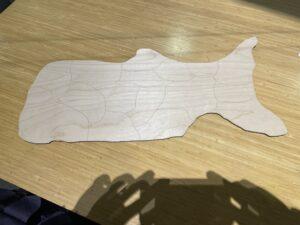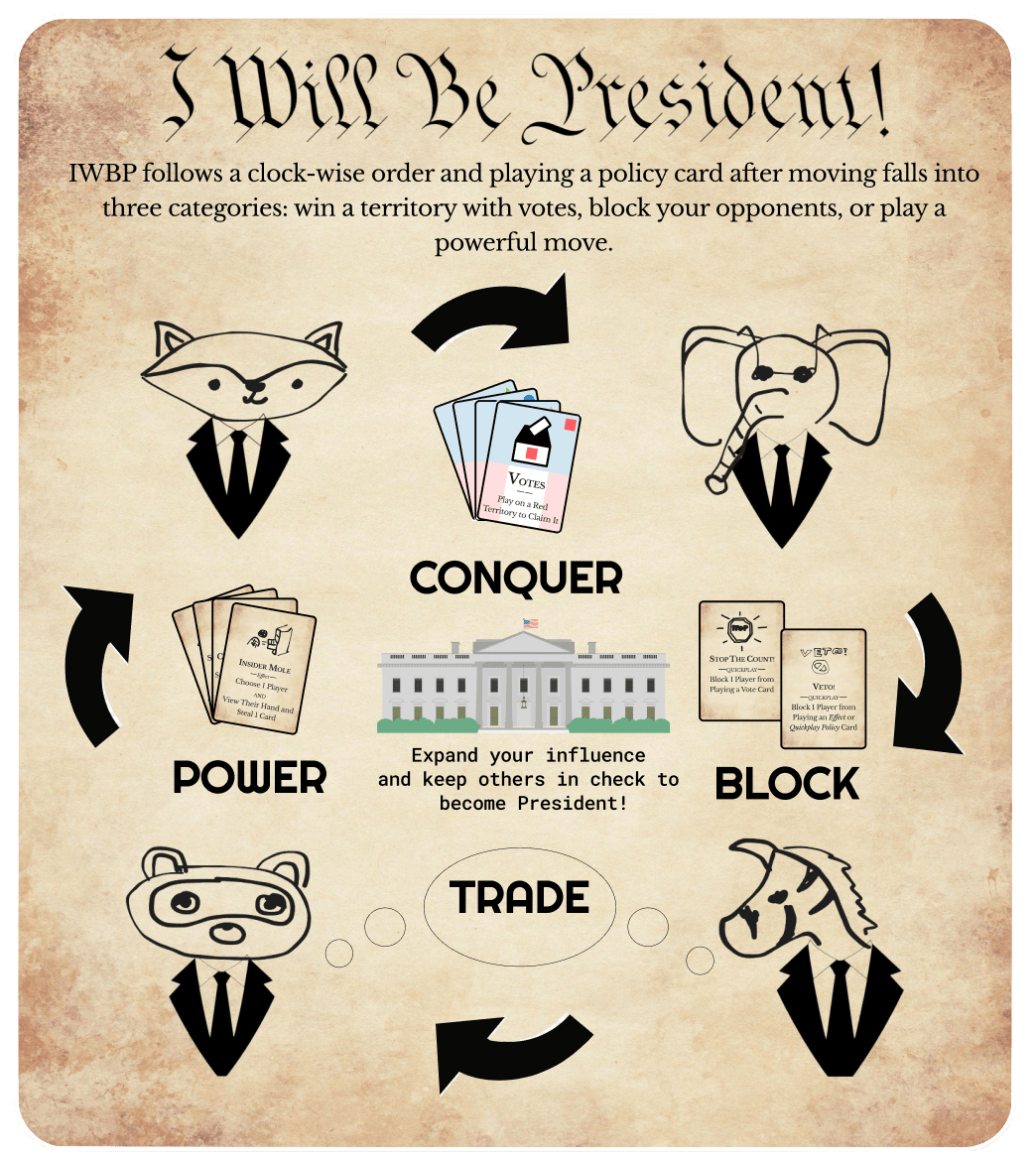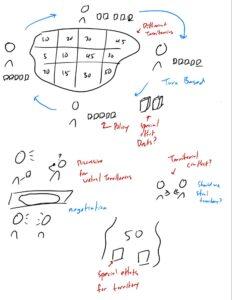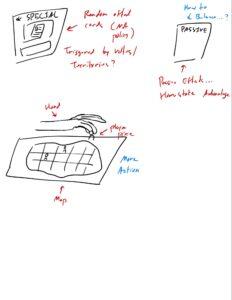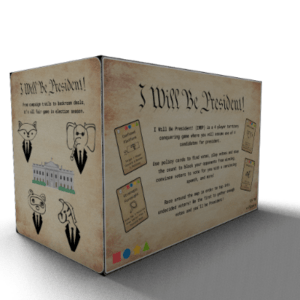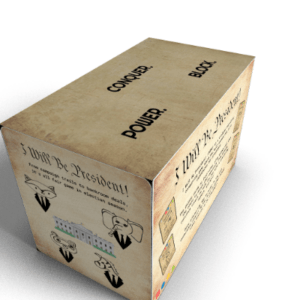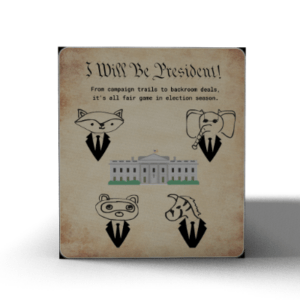I Will Be President!
Artist’s Statement
I Will Be President (IWBP) is a territory control game which emphasizes fun through fellowship, challenge and competition between players. Each of our players takes on the role of a presidential candidate and must navigate between other candidates to gain the votes of the citizens of each territory. Throughout the game, players must use strategy – preparing combos, preventing obstacles – in order to gain the votes from each territory. IWBP is intended to be a casual party game where you can feel both great delight seeing the map be filled with your own marker and one where you can drop a casual swear when your plans are foiled!
Since we value high player skill expression and interactions between players, we designed multiple mechanics which allow for players to effectively plan their next move and always be one step ahead of the other players. We incorporated challenges by including cards which have strong combo power, allowing players to constantly cycle through the deck, as well as disrupt cards which can stop other card effects from resolving. Additionally, in order to create a sense of fellowship amongst players, we incorporated trading as well as speeches as mechanics that players can use to push for an advantage.
IWBP is a game made to incite excitement and despair as players compete against each other to take control of the map through their combos and disrupt options – all interactions which we hope will inspire fellowship and fun amongst players.
Ideation Sketches To Concept Map
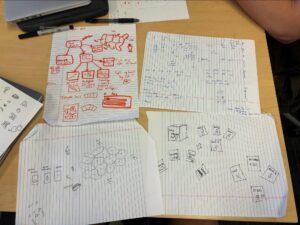
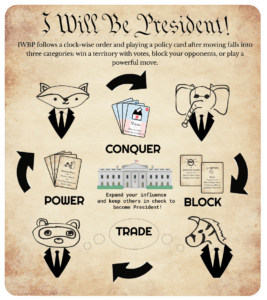
Initial Decisions About Formal Elements and Values
When we first started to envision our game, we knew that we wanted to make a strategic territory based board game. We’ve grounded our design and decision-making in several key principles that reflect our values in a strategy board game. These include (1) the expansion of one’s territory, (2) types of playable cards (dimed policy cards), (3) and fellowship mechanics.
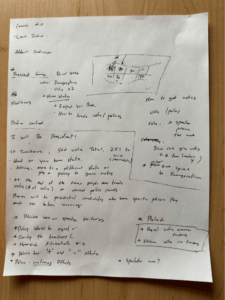
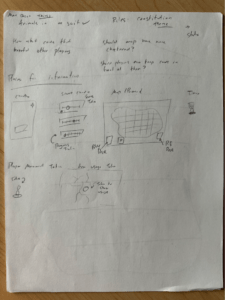
The initial manifestation of the game
- Expanding Individual Territory: With a name titled “I Will Be President”, which was an initial starting point in the ideation phase, we took inspiration from the election process in the United States. In this process, candiaties campaign over states and “win” a territory according to votes. Ideating this concept to a board game, it was clear that players needed to strategically navigate a board, gain control of territories in some form, and repeat until there was a president announced. From this, the foundations for IWBP were built and we based our decision-making on this concept.
- Types of Playable Cards: In one of our group game sessions we played Omerta, a strategic card game where players need to get rid of cards and call “Omerta” at the end. Some cards contained special mechanics that almost always gave a player an advantage, such as peaking at another’s hand, stealing cards, and giving more cards to other players. We took inspiration from Omerta to introduce special ability cards into our game on top of our standard Vote cards. We experimented with the abilities of these special cards and we initially planned to include Multiplier (in association to a previous Vote card), Veto (overturn another player’s card), and Flight (change map position) cards. After play-testng, and changing some winning mechanics, we only kept Vote and Veto cards but integrated many more exciting cards to add excitement to the game.
- Fellowship Mechanics: Similar to other territory based board games, we wanted to include trading mechanics to the game. Our initial decision was to allow every player to play their turn and at the end of the round players could trade amongst themselves if they wanted to. We envisioned that if another player had a card that an individual needed or wanted, then they should have a method for obtaining that card. During our initial playtests, we found that low-value cards had little functionality to our game and trading was limited because players were hoarding all high-value cards, reducing fellowship and strategy. In our final stages, we changed the winning conditions to incentivise players to trade based on their hand and added improv to increase fellowship.
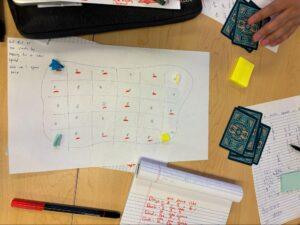
The first version of IWBP
The earliest ideation of our game contained the following:
- Players: Drawing inspiration from Omerta, which accommodates 3-4 players, we wanted a game that pinned players against each other in a small group setting. We chose to keep our game 4-player, fitting the size of our group and experiences with Omerta.
- Objective & Outcomes: The objective for each player is to be the first to reach 251 votes and play 3 specific policy cards, meaning that players are required to traverse and interact with the board (ideally with other players too). The outcome of the game is based on a chart that tracks players’ vote counts individually, so when the game conditions are met there is one President announced and 3 runner ups depending on vote comparisons.
- Procedures & Rules: The game functions on a per-round basis. On each turn, a player can either move to an adjacent territory on the board or play a policy card. After a single round (all players have completed these actions), players can choose to trade amongst themselves. The game continues in a clockwise direction until a President is announced.
- Resources: A game board, a deck of policies, 4-player tokens, a vote chart and players.
- Boundaries: We bounded the game based on the number of votes one has to achieve before winning and the natural boundaries of the board game. While the game allots for a finite amount of game time, players are not rushed in taking turns so they can carefully consider their options.
Play Testing and Iteration History
Play Test 1
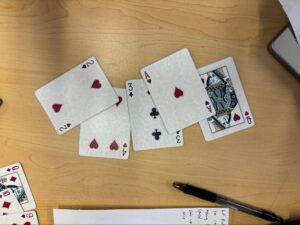
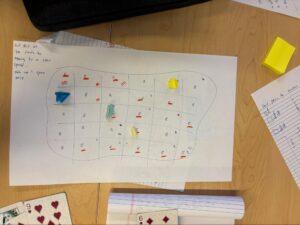
For Play Test 1, we decided to simulate elements of negotiation, speed, and deception via a card deck exercise. In this card deck exercise, each player was given five cards and players incrementally added to the deck of cards on the table. If one couldn’t advance the increment by one, they drew a card. The win condition was when a person got rid of all their cards.
We also leveraged game board movement to simulate alliance-building, displays of power, and identity stalemate situations. Players drew cards, and if their card color matched the spot they were on, they could claim it and move to another spot on the board. This exercise ended when a player won the majority.
What Worked: Cunning tactics, relying on social relationships, loyalty testing, showing desirable cards, positive attitudes toward similar negotiators, mirroring previous rounds.
What Didn’t Work: Stalemates due to randomness/chance, lies damaging relationships permanently, liars that alienated players, blurred internal game/external relationship boundaries, prioritizing self-interest over collaboration, ties broken selfishly.
Setting: In-Class, 4 Players
Play Test 2
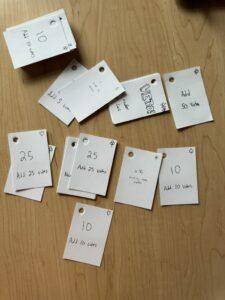
Based on Play Test 1, we had a firm understanding of the gameplay behaviors underpinning card play (namely, negotiation, deception, implicit biases, etc) as well as how they related to territorial gameplay dynamics. For Play Test 2, we decided to incorporate a system of votes and action-cards to see how they affected this existing system. We wanted to see how testers would react to having dual goals (i.e., collecting votes and playing a unique card from each suite on a given play).
What Worked: Distinct dual goal instructions, veto power dynamics/strategy, sufficient board movement, sufficient card distribution, end-game competitiveness.
What Didn’t Work: Confusion around stealing/trading cards, uncertain veto rules, unclear movement mechanics, suite goals too easy, lack of negotiation motivators, players focused on self over interaction.
Setting: In-Class, 4 Players
Play Test 3
Following our feedback on Play Test 2, we designed Play Test 3 to have more player actions and tried to improve our trading system. We did this by allowing players up to three actions which included moving on the map, playing an effect card, and playing a vote card. Additionally, we wanted to lean into trading more. We noticed that in Play Test 2, players were reluctant to engage in trading when there was a fear of deceit. To combat this, we required trades to be truthful.
In Play Test 3, the game’s mechanics worked well and players were able to do a variety of actions during their turns. We also had some trading among players, but trading was done with very little card diversity. We had managed to fix the issues that appeared in Play Test 2.
What Worked: Base mechanics worked well, players were happy with multiple actions per turn.
What Didn’t Work: The game win condition was too hard to fulfill, resulting in games never finishing, even after hours of play. Trading was ineffective as players only ever traded their worst cards
In order to improve on the first problem, we relaxed the win condition from controlling nine territories total to controlling four territories which matched their candidate’s color and one additional territory. We also added more effect cards which would help players to search for vote cards and otherwise cycle through the deck more efficiently.
In order to act on the second problem, we reviewed all card effects and removed some especially weak cards and rebalanced cards so that each card was perceived to be “good”. We hoped that if the lower floor of usefulness was lifted, we could lessen the gap between the best and worst cards in the deck. Additionally, we found that several cards only worked when at least one territory was controlled, so we also changed the starting state of the game.
Setting: Out of Class, 3 Players
Play Test 4
For Play Test 4, we tested with a rebalanced deck and a less strict win condition. In general, the removal of previously perceived “weak” cards proved to be effective in increasing the enjoyment that players had of the game. Additionally, trading became more prevalent and a greater diversity of cards were traded between players. However, we note here that this play test was done among friends (of which one was a designer of IWBP) so trading could have also been a product of pre-existing social dynamics rather than IWBP’s mechanics.
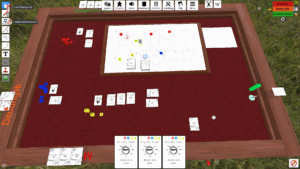
Play Test 4 was played on Tabletop Simulator with 3 players
What Worked: Game sped up and players engaged in trading with much more diversity in cards.
What Didn’t Work: Game win condition was reasonable, but with many disrupt cards, it was hard to maintain enough territories to even try and push for a win.Vote cards which did not share the same shape as your candidate did not contribute to winning and felt like a waste to use
Play Test 4 was pretty successful. We were pleased to find that players enjoyed interacting with each other (though combos, steal cards, and disrupt cards) and also engaged in trades with each other. The major improvement we had to make was to reduce the total play time of IWBP.
To shorten the game, we decided to further relax the win condition to controlling three territories which matched your candidate’s shape and one additional territory. We also added a secondary win condition of controlling six territories total to give players a reason to capture all territories.
Setting: Virtual, 3 Players
Play Test 5
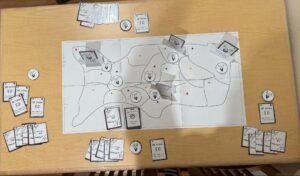
Play Test 5 was a relatively successful iteration of our physical prototype. With no guidance from our end, players were able to extract the necessary rules of gameplay and play a few rounds of the game – with noticeable laughter, excitement, nervousness, triumph, defeat, and more.
What Worked: Visual win condition cues, stealing territory incentives, good pace and momentum of gameplay, action cards understanding and execution, clear path to winning for some players.
What Didn’t Work: Long instructions lost attention, confusion over ambiguity in instructions, card/territory rule confusion, reluctant trading causing stalemates, lack of alliance incentives.
Based on our players’ feedback, we significantly condensed our rulebook, clarified the requirements or card combinations necessary to execute a certain move (improving card-movement mental connection for players), and created win conditions that allowed for trading to occur organically.
Setting: In-Class, 4 Players
Final Prototype
Video of Final Playtest
https://youtu.be/Nq0QAlUY3lQ?si=S3AHnPbrSBLDIfXo
Print and Play
https://drive.google.com/drive/folders/1u__woJjzOzA50ardEIyVHqgD_-vduO2-
Rulebook
https://docs.google.com/document/d/16nCiNs8Bvky7bK3qXaTHgD_Zv4pd4OdEy6BPwlUvJx0/edit?usp=sharing
Figma Assets
Rulebook Sample
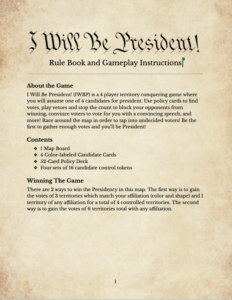
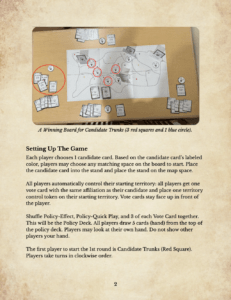
3D Box Design
Mockups (Front + Back)
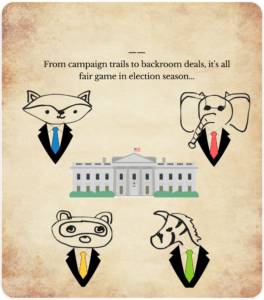
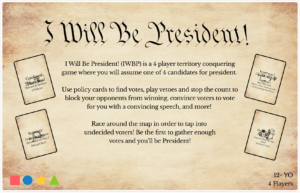
Physical Gameplay


